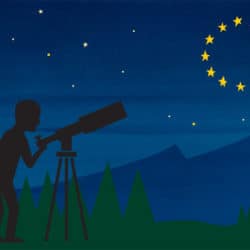This is the first in a series of articles on Indigenous Communities and Philanthropy.
In his 5th Century, BCE, play “Prometheus Bound,” the Greek playwright Aeschylus tells the tale of Prometheus, son of Zeus, taking pity when he encounters a group of sickly creatures. Prometheus provides them with two special gifts: fire and blind hope. The gifts are transformational and the creatures become human; complex and conscious beings. The gift was an act of philanthropos or “loving” “humanness.” This is the origin of today’s word “philanthropy.”
Move forward 2000 years and into the “new” world, and we find another group of creatures nearing the end of all hope. It is the winter of 1535-36. The explorer Jacques Cartier and his men are near death, losing the battle against winter in a fort built near present-day Quebec. In a latitude similar to that of central France, Cartier thought he had anticipated the rigors of winter. He was, of course, mistaken. Temperatures had plummeted, food was scarce, and the condition of the crew had become critical. A note in a journal from the Cartier expedition: “Sometimes we were constrained to bury some of the dead under the snow, because we were not able to dig any graves for them, the ground was so hard frozen, and we so weak.”
Many of Cartier’s men were suffering from an unfamiliar malady. All attempts by the ship’s physician and continuous prayer could not effect a cure. Domagaia, a local Indigenous leader who had travelled to France with Cartier the previous year, had sickened also, but several days later he was seen near the encampment in perfect health.
When asked, Domagaia sent women from the nearby community with branches of what was likely sassafras. The women showed Cartier’s men how to make medicine from the bark, but was it poison? The men worried: “…there was none durst taste of it, except one or two, who ventured the drinking of it, only to taste and prove it: the other seeing that did the like, and presently recovered their health, and were delivered of that sickness.”
The journals make no suggestion of trade or exchange for that gift of medicine. The health of his men restored, Cartier continued his voyage in the spring and again returned to France with stories of the “new” world. For better or worse, the course of the complex history of relationship between indigenous and non-Indigenous peoples in Canada was set. And it rests on the first written record of a gift: philanthros, loving humanness – a gift that healed in Canadian history.
Very much went tragically awry in the next chapters of this story. 480 years later, the Truth and Reconciliation Commission, the Canadian government’s apology, and many other efforts to make restitution for all the harm that transpired from those early relationships not only to Domagaia’s people but to many other Indigenous men and women in children in Canada. The word reconciliation means to make good again, to create repair. At The Circle on Philanthropy and Aboriginal Peoples in Canada, we like to think about reconciliation as the work of every Canadian and philanthropy as one of the ways we return to humanness in our relationships.
The circle, the symbol we have chosen for our work, is a powerful symbol in most cultures. From the knights of the Round Table in England to the yin and yang of the East and the medicine wheel, the circle is symbolic of equity, balance, and strength. The logo of The Circle on Philanthropy and Aboriginal Peoples is incomplete – space is left for learning and for others to join and contribute. We drew it this way deliberately, because we see ourselves as an expanding space for learning and understanding.
In the last several years, part of our work has been to “see” and describe the landscape of Indigenous philanthropy in Canada, and to create an understanding of philanthropy as a part of reconciliation – first the building and then healing of right relationship. Measuring The Circle: Emerging Trends in Philanthropy for First Nations, Metis and Inuit Communities in Canada, is the most recent of the publication arising from this work. As our view expands through projects like this study, we see new questions, and the next set of relationships brings new ideas. Our engagement as guest editors with The Philanthropist invites a yet wider view of the way philanthropy plays into the repair of culture and community. Three main themes flow through this issue.
1. Exploration of unique traditions of giving and sharing between Indigenous and non-Indigenous peoples in Canada.
While the language philanthropos is, like many non-Indigenous Canadians, the product of another continent, there are rich traditions of giving and sharing shaped by life and tradition on this land over thousands of years. Canadians donating or sharing wealth through granting for social purpose is perhaps most visible. But with this series on Indigenous Peoples and Philanthropy, we explore some of the less visible traditions and the language of caring and sharing in Indigenous communities.
2. Recognition and an honest accounting of where philanthropy has gone wrong or where traditions of Indigenous philanthropy have been suppressed.
Though the story of Cartier and the medicine is widely known, the next chapter is rarely told. Cartier attributes the cure not to the gift but to an answer to the men’s prayers. Sadly, they found not gratitude but strife from the gift: “After this medicine was found and proved to be true, there was such strife about it, who should be first to take it, that they were ready to kill one another, so that a tree as big as any Oak in France was spoiled and lopped bare within 5 or 6 days.”
With some important exceptions, much of the subsequent history of philanthropy in Canada cannot be said to represent caring, sharing, or love of humanness. Several contributors tell stories of banned traditions of Indigenous philanthropy, such as the potlatch. Others write about the destructive paternalism of “new world” philanthropy, such as the role in residential schools.
3. A sample of successes and opportunities which are leading to stronger communities in Canada and around the globe through philanthropy.
We see new hope on the landscape for philanthropy. Dormant and oppressed traditions of community caring and sharing are re-emerging. Non-governmental funding supports good projects that foster self-determination in communities, building capacity to recover tradition and strength and to find new ways forward. Crowd-sourced platforms enable Canadians to donate directly to projects that matter. In this, we see the connection to reconciliation and an opportunity to change the narrative between Indigenous peoples and settler or newcomer culture. Several contributors will provide examples of how today’s philanthropy in its different forms is leading to new and exciting possibilities.
To our knowledge, this series in The Philanthropist represents the first time that shared traditions of sharing and caring have been explored in this way. As a collective network of philanthropic organizations, communities, and individuals, the Circle has been working for several years to facilitate the hard conversations, build trust, and identify opportunities. It is not an easy or comfortable journey. We invite you to join us.
100 Words for Philanthropy Twitter Campaign
Please help us build our list of language and traditions of philanthropy in Indigenous culture.
Here is some of what we have learned already:
Iqasuk is used by Inuit elders translated as ‘giving kindly without conditions’ because its deepest meaning is generosity. It usually means kindness from the beginning, even when one is young.
Miizhyang in Ojibwe means “give”
Okamanii iihtáóhopommao’p in Blackfoot means “Asking” and Tsiiksiiksiimatsitisip “to be grateful”

